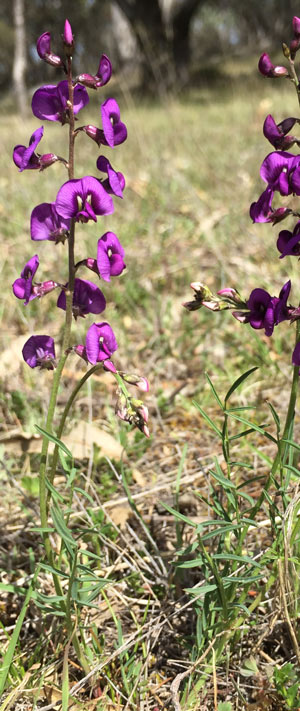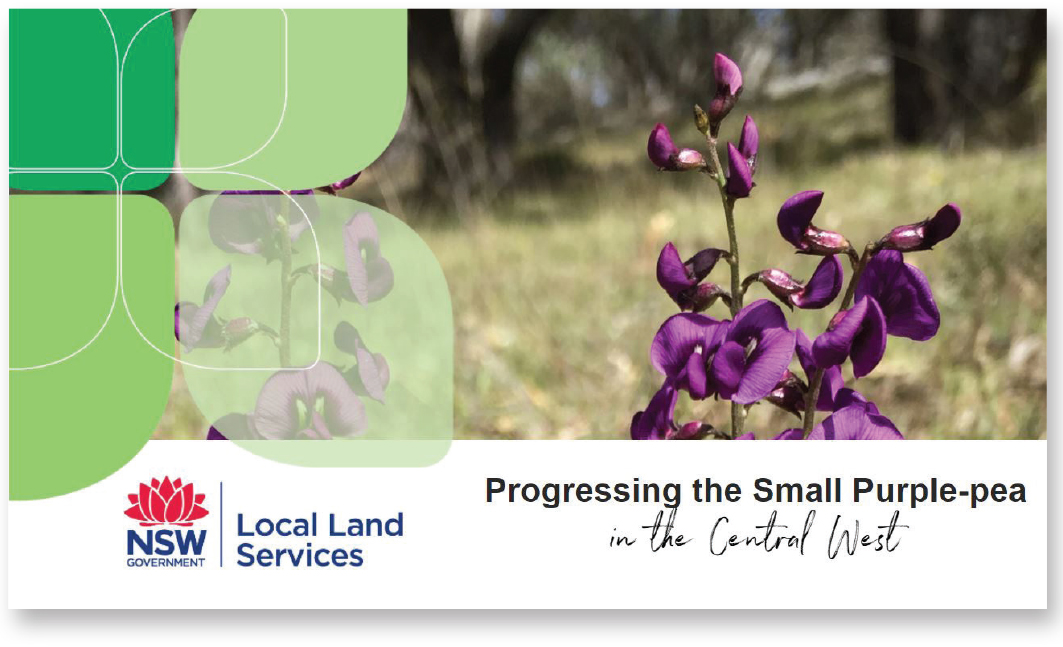Progressing the small purple-pea
Help us find the small purple-pea (Swainsona recta)
Local Land Services, with the support of the Australian Government’s National Landcare Program, are seeking your help in their efforts to locate new populations of the nationally endangered small purple-pea.
This beautiful plant has suffered the loss of its woodland habitat and together with your support, we are hoping to secure its survival into the future.
If you think you might have seen this plant, please contact us!
All sightings of the species are important and will allow us to care for the small purple-pea in our region.
What does it look like?
- slender plant, up to 30 cm when flowering
- narrow, hairless leaves
- hot pink to purple flowers on elongated stem
 The small purple-pea is a small perennial herb, which, when flowering, can grow to 30 cm tall.
The small purple-pea is a small perennial herb, which, when flowering, can grow to 30 cm tall.
The leaves are almost hairless and divided into up to six pairs of 10mm long, narrow leaflets, each with a pointed tip. There is also a single leaflet at the end of each divided leaf.
It flowers between late September and early December, with each plant bearing one or more sprays of purple flowers.
For most of the year the plant remains dormant underground until conditions are right for flowering and seeding.
Most known populations of the small purple-pea occur within grassy woodland, with the plants growing in-between grass tussocks in more open areas. In drier areas, such as near Wellington, they are also found growing in woodland with native cypress pine.
The small purple-pea appears to persist in areas that have not been heavily grazed. Keep an eye on roadsides and bush areas where native shrubs and grasses still exist.
Video
Expanding the reach of the Small Purple-pea – Richard Ivey
After the Small Purple-pea (Swainsona recta) was discovered on a small section of their property, Jo and Richard Ivey agreed to participate in a project supported by Central West Local Land Services.
A 7 ha area containing the endangered plant was fenced out, and an alternate watering point was installed outside the protected area.
Digital Magazine
Contact us to find out more
How you can be involved about the project and how you can be involved, please contact:
- Libby Mcintyre by emailing libby.mcintyre@lls.nsw.gov.au
If you find a plant you think might be a small purple-pea, take some photos and location details and contact us for assistance with identification.
Similar species
Some other purple peas that the small purple-pea can be confused with:
Southern swainson-pea (Swainsona behriana)
- Low growing, thicker, slightly rounder leaves
- Short flowering stem, flowers bunched at the end of the stem
Silky swainson-pea (Swainsona sericea)
- Leaves are thicker, very hairy and silver in appearance
- Short flowering stalk, flowers bunched at end of stem
Smooth Darling-pea/ cranky pea (Swainsona galegifolia)
- Tall, bushy with pale pink flowers
- Larger leaves with many, rounded leaflets
- This plant is poisonous to stock
What is being done?
- Regional surveys to identify new populations of Swainsona recta
- Mapping and modelling of potential habitat areas
- Control measures that reduce threats to the species in known habitat areas
- Identification and education workshops held across the Central West region in conjunction with Landcare groups
- Subsidised accredited training to undertake Certificate II in Conservation and Land Management
- Accredited fire management training provided to Aboriginal groups and communities
- Ecological burns will be undertaken with Aboriginal groups to improve the quality of habitat and extend populations
- Monitoring of current and new plots.
This project is supported by Central Tablelands and Central West Local Land Services, through funding from the Australian Government’s National Landcare Program

